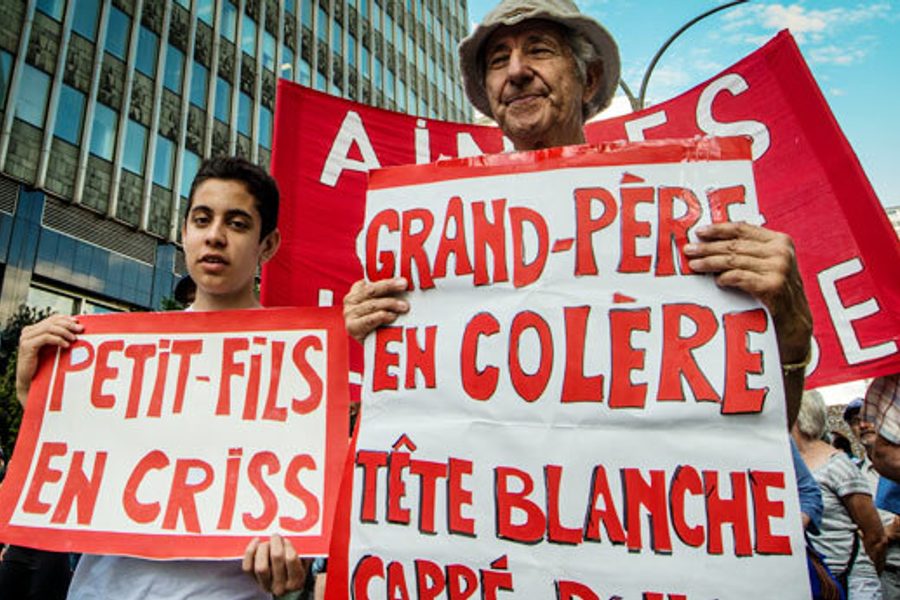
A simple red square of fabric, pinned to a T-shirt or jacket, is the symbol of a movement that has taken over a Canadian province. It comes from the French — “carrément dans le rouge,” or “squarely in the red” — an emblem of the debt that students in Quebec carry as the cost of higher education rises. But that red square has inspired activists from Brooklyn to Brazil — and like the movement it represents, it has come to signify more than just a tuition fight.
“All over the world we see a need for democracy and legitimate student power. We need free education, and we need student debt forgiveness,” says Biola Jeje, an activist from CUNY Brooklyn College, who visited Quebec and brought red squares — and inspiration — back with her to New York.
Young people are being asked to bear a double burden for mistakes they didn’t make, paying more in tuition to go to school — and then facing dismal job prospects when they get out. Paul Mason, author of the book Why It’s Kicking Off Everywhere, calls them “the graduates with no future.” No wonder their generation is in revolt.
Things kicked off in Quebec in February, after Premier Jean Charest’s government announced tuition hikes of 75 percent over the next five years. Department by department, student unions voted in general assemblies not only to stop going to class, but to picket outside university buildings, shutting down classes entirely. At the height of the strikes, some 180,000 students took part.
But the students’ fight was about more than tuition.
“Students have become well aware that [the tuition hike] is a symptom of larger social issues, namely neoliberal, austerity policies,” says Jérémie Bédard-Wien, finance secretary for the Association pour une Solidarité Syndicale Étudiante (ASSÉ), which he describes as “the latest organization representing the combative side of the movement.” From ASSÉ, the student unions built a strike-time coalition, CLASSE, that represents many of the most radical activists.
Historian Jacob Remes, who teaches about social movements in the U.S. and Canada at SUNY Empire State College, points out that Quebec has long seen itself as a “distinct society” from the rest of Canada. The effort to preserve the French language and culture within the province is connected to the struggle for a broader social democracy. “People are fighting for this Quebec model,” Remes says.
Recognizing the threat posed by the students, the government at first attempted to force them back to class. When that didn’t work, the National Assembly of Quebec escalated the battle, passing the so-called “loi matraque,” or truncheon law. Bill 78, which the government declared an emergency measure, suspended the school semester until August (effectively turning the strike into a lockout) and banned protests without prior permission from police.
The province erupted in outrage. Just days after the bill was passed, on May 22, as many as 300,000 Quebecois took to the streets, creating what Remes calls the largest act of civil disobedience in Canadian history. Inspired by Latin American protests, people began to bang pots and pans (casseroles) in the streets; first on a corner or even out a window within their neighborhoods, but soon in ever-larger (illegal, according to Bill 78) marches through the streets.
The Quebec protests were largely ignored by the mainstream U.S. media (and even the English-speaking media within Canada). Just as outsiders found themselves streaming Al-Jazeera to find out the latest from Egypt, people looking for updates on the Quebec movement have had to find or create other sources — like the blog Translating the Printemps Érable, which translates Francophone media into English to spread news of the movement.
Anna, one of that blog’s founders and a professor who asked that her last name not be used, says that before Bill 78, the movement felt like it was about students. “Post-Bill 78,” she says, “the movement went from people like us joining the movement as a way of standing in solidarity with the students, to people like us joining the movement because it was now our movement, too.”
Negotiations with the government fell apart in May when students deemed its offer — to reduce the proposed tuition hike by $35 a year over seven years — insignificant. When government negotiators refused even to discuss Bill 78, students and their supporters returned to outside action.
“CLASSE is sponsoring a series of conferences in 17 cities exposing our political analysis and goals, as well as setting out a clear course of action for a broader general strike of Quebec society against austerity measures,” says Bédard-Wien. They’re also planning demonstrations on the 22nd of each month through the summer.
The casseroles have cooled off a bit, but Anna says that, inspired by their energy, people are beginning to organize neighborhood assemblies where they gather together to discuss issues facing their communities and keep up the movement energy.
The larger question is whether the movement will impact the province’s Liberal government. Anna says that it is likely that Charest will call an election during the summer, not only because of the student movement but because observers believe the administration stands to benefit by holding one before a corruption inquiry resumes in the fall. Recent polls show plummeting support for the tuition hikes, but those polls don’t offer a clear answer as to whether Charest’s government may fall, or whether it could be replaced by one more supportive of the students.
Organizing for themselves
The movement has been felt in the United States. On April 25, students at Brooklyn College in New York adopted the red square for a protest against student debt, which that day crossed the $1 trillion mark. “The red square that I saw in Quebec really resonated with me and I wanted to bring that here,” says Jeje.
“That’s one of the trajectories of transnational movements: let’s pick up their slogan, pick up some of their analysis, pick up their iconography,” Remes says. “That’s something we can see with the red square; we like your iconography, but we don’t feel a need to build our movement precisely the same way.”
U.S. students face multiple challenges in trying to build a mass movement, and will need different strategies to do so. “The system of all-public universities and colleges [in Quebec] is very different,” Remes noted. “One of the real problems one would have in the United States is getting over the public-private difference.” The targets for activism are obviously not the same at public institutions like Brooklyn College or Ohio State, as at regional private schools like Franklin University, or Ivy League universities like Yale.
One idea catching on with U.S. student activists is Quebec-style student unions, elected by the student body and legally recognized as representatives of the students. “Even before I began organizing, I always wondered why there were so few broad-based student organizations,” says Stuart McIntyre, a student organizer at Ohio State University. “I’ve always felt that unity (with space for difference) is necessary to build power.”
Organizing and activism on U.S. campuses has long been based on advocacy for others, rather than students organizing in their own self-interest. “Universities have been really good at encouraging that outward-facing advocacy and not the inward-facing stuff,” says Remes.
When activists do target universities, they’re often doing so in solidarity with workers, not for themselves, such as the recent hunger strike campaign for a living wage at the University of Virginia, or United Students Against Sweatshops. While students have organized against tuition hikes — like in the University of California system — those protests have not created a broad-based movement that acts in their own interests.
“Our universities cannot prepare us for life in a democratic society if they’re not even democratic themselves,” McIntyre says. “We say ‘no tuition without representation’ because the stakes are high: public education and democracy are under attack, and the university is a battleground for both of these struggles.”
Both Jeje and McIntyre have been building student organizations on their campuses, and also in larger statewide organizations. The Brooklyn College Student Union was founded as a reaction to tuition hikes in the spring of 2009, and it works with umbrella groups like Students United for a Free CUNY and New York Students Rising.
“We work to address the concerns of students that are often silenced and want to build power on our campus in a way that provides for a legitimate alternative to student government, which in our experience only serves the interests of the administration under the false pretense of listening to the student needs,” Jeje says.
Ohio students have also formed a statewide organization. “The Ohio Student Association is a political organization, and part of our mission is to organize for social justice,” McIntyre says. “We wanted to create a space where students could re-imagine the university as a democratic institution.”
U.S. students may not be ready for a massive general strike yet, but they’re starting to think bigger. In August, Columbus, Ohio, will host a national student power conference, where organizers from around the country will strategize to build broader campus organizations and plan for the coming year.
August will be critical for Quebec as well, as the semester cut short by Bill 78 begins again. “We expect students to continue enforcing their democratically voted strikes,” says Bédard-Wien. “This time, we’ll win.”
Sarah Jaffe is a writer and reporter living in New Orleans and on the road. She is the author of Work Won’t Love You Back: How Devotion To Our Jobs Keeps Us Exploited, Exhausted, and Alone; Necessary Trouble: Americans in Revolt, and her latest book is From the Ashes: Grief and Revolution in a World on Fire, all from Bold Type Books. Her journalism covers the politics of power, from the workplace to the streets, and her writing has been published in The Nation, The Washington Post, The Guardian, The New Republic, the New York Review of Books, and many other outlets. She is a columnist at The Progressive and In These Times. She also co-hosts the Belabored podcast, with Michelle Chen, covering today’s labor movement, and Heart Reacts, with Craig Gent, an advice podcast for the collapse of late capitalism. Sarah has been a waitress, a bicycle mechanic, and a social media consultant, cleaned up trash and scooped ice cream and explained Soviet communism to middle schoolers. Journalism pays better than some of these. You can follow her on Twitter @sarahljaffe.









